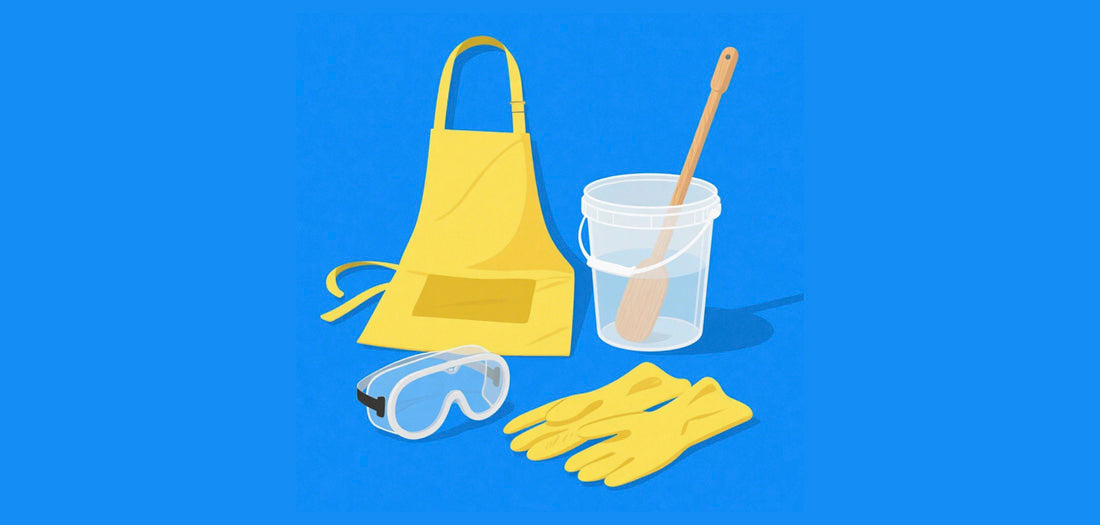
How to Safely Use Muriatic Acid in Your Pool to Balance pH and Alkalinity
Share
Muriatic acid is one of the most affordable and effective ways to lower your pool’s pH and alkalinity. It’s also useful for cleaning pool filters and concrete surfaces. However, because it’s a strong acid, adding it to your pool requires careful handling to avoid injury or damage.
Below is a complete step-by-step guide on how to safely use muriatic acid in your pool.
Tools and Materials:
Muriatic acid (hydrochloric acid)
Protective gloves and goggles
Plastic measuring container
Plastic watering can or pool acid dispenser
Pool test kit or digital pH tester
Pool brush (optional)
Plastic bucket (optional)
Step-by-Step Guide:
Step 1: Test Your Pool Water
Before adding any chemicals, test your pool's pH and alkalinity using either test strips or a digital test kit. A digital test kit is more precise and gives a clearer understanding of your pool's chemistry.
- Ideal pH range: 7.4 – 7.6
- Ideal alkalinity: 80 – 120 ppm
If your pH is above 7.8, adding muriatic acid can bring it back into the ideal range. However, it’s essential to add acid in small doses and retest to avoid overcorrection. Tip: If you notice the pH is too high, use the smallest amount of acid possible to make gradual adjustments.
Step 2: Calculate How Much Muriatic Acid to Add
To determine the right amount of acid, you need to know your pool’s volume in gallons. If you’re unsure, you can use an online pool calculator.
A general guideline:
- 20 ounces of muriatic acid will lower total alkalinity by 10 ppm in a 10,000-gallon pool.
- To prevent overcorrection, add no more than ½ gallon at a time before retesting.
Tip: If the pH drops too low, you can naturally raise it by aerating your pool (running fountains or return jets) instead of adding more chemicals.
Step 3: Add the Muriatic Acid
Option 1: Diluting in a Bucket (Recommended Method)
- Turn off the pool pump and wait for the water to settle.
- Fill a plastic bucket with water, then slowly add the muriatic acid to the water. Follow a 10:1 water-to-acid ratio (10 parts water to 1 part acid) for safe dilution.
- Stir gently using a plastic or wooden stir stick to mix the acid and water.
- Carefully pour the diluted mixture into the deep end of the pool. Move away as you pour to avoid inhaling fumes.
Option 2: Pouring Directly into the Pool
- Slowly pour the acid into the deep end while walking away to avoid inhaling fumes.
- Turn your face and body away from any rising vapors to protect your eyes and respiratory system.
- Avoid pouring near return jets or aerators, as the acid will react too quickly with the water.
Important: Never mix muriatic acid with other chemicals, and never pour it in the same spot as recently added chlorine. Mixing these chemicals can create dangerous gas fumes.
Step 4: Let the Acid Circulate
Turn the pool pump back on and run it for at least 5 hours to ensure the acid is distributed evenly.
If your pool filter has a multiport valve, set it to “circulate” instead of “filter” to avoid acid buildup in the filter media.
Some pool owners use a method called pooling—turning off the pump and letting the acid settle to target the alkalinity. However, this can damage the pool’s surface if not carefully monitored.
Step 5: Retest Your Pool Water
After five hours, test your water again. If the alkalinity and pH levels are still too high, add another small dose of muriatic acid and repeat the process.
It may take several rounds of treatment to reach ideal levels. If you find that your water chemistry isn’t changing as expected, take a sample to a pool store for professional testing—your testing method might not be accurate.
Step 6: Aerate Your Pool if Needed
If your pH dropped too low but your alkalinity is balanced, aerating your pool can help bring the pH back up naturally.
To aerate your pool:
- Point return jets upward to create surface disturbance.
- Turn on water features like fountains or aerators.
- Run the pump at high speed to speed up the aeration process.
If aeration alone doesn’t raise the pH enough, you may need to add a pH increaser, but do so carefully to avoid raising alkalinity again.
What If Your pH Stays Too High?
If multiple doses of muriatic acid lower alkalinity but pH remains high (above 8.0), continue adding small rounds of acid as needed.
- Temporary drops in alkalinity are normal—it should balance out over time.
- If alkalinity drops too low, you can add baking soda to raise it slightly (but keep in mind, this will also increase pH).
- While pH decreasers (dry acid) are an option, muriatic acid is cheaper and more effective for lowering both pH and alkalinity.
Is Muriatic Acid Safe to Use?
Muriatic acid is similar to hydrochloric acid, commonly used for cleaning masonry surfaces. While it’s effective for pool maintenance, it’s highly corrosive and requires proper handling.
Safety Tips:
- Wear full protective gear (goggles, gloves, apron, and mask).
- Never mix muriatic acid with other pool chemicals.
- Store in its original container, away from sunlight and moisture.
- Have a hose nearby to rinse off any accidental spills.
- Use baking soda to neutralize small acid spills immediately.
How to Clean Pool Filters with Muriatic Acid
Muriatic acid is also useful for cleaning cartridge and D.E. filters, but always follow safety precautions.
How to Clean a Cartridge or D.E. Filter:
- Remove the filter element and rinse it thoroughly with a hose.
- Fill a large acid-proof container with water.
- Add muriatic acid in a 20:1 water-to-acid ratio (always add acid to water, not the other way around).
- Submerge the filter and let it soak overnight.
- Rinse the filter thoroughly and reinstall it.
For a detailed filter-cleaning guide, refer to our Pool Filter Cleaning Guide.
FAQs About Muriatic Acid in Pools
How long does it take for muriatic acid to lower alkalinity?
You should see a difference within 1–2 hours, but let the water circulate for at least 5 hours before retesting.
Is muriatic acid the same as cyanuric acid?
No. Cyanuric acid is used as a chlorine stabilizer, while muriatic acid is for pH and alkalinity control.
Can I pour muriatic acid straight into my pool?
Yes, but diluting it first is the safest option. If adding directly, pour into the deep end and walk away immediately to avoid inhaling fumes.
What happens if I add too much muriatic acid?
Too much acid can lower pH too much, leading to skin irritation and corrosion of metal components. If this happens, aerate the pool or add soda ash to rebalance.
When can I swim after adding muriatic acid?
Wait at least 1 hour, then test the water before swimming. If pH is balanced, it’s safe to swim.
By following these steps, you can safely use muriatic acid to keep your pool water balanced, clear, and comfortable for swimming.
